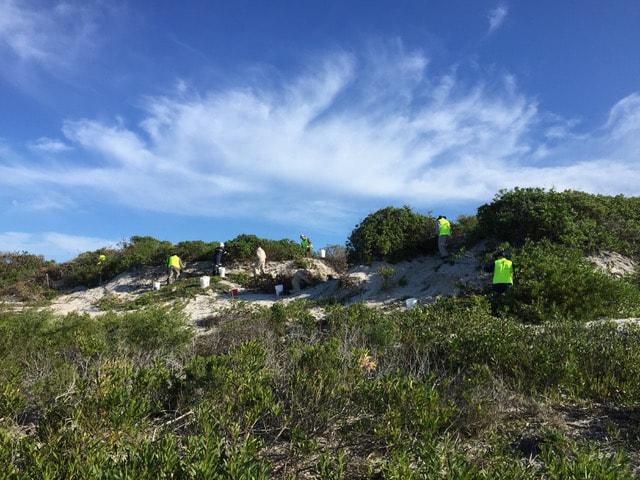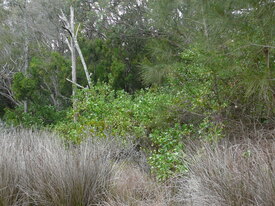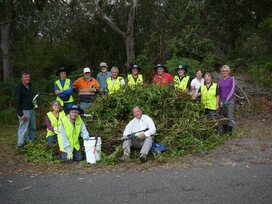Bitou bush is a major threat to NSW that seriously impacts coastal ecosystems and biodiversity.
In 1999, bitou bush was listed in NSW as a noxious weed of national significance.
One hundred years ago the first bitou bush plant was recorded as naturalised in Australia, growing in coastal vegetation at Stockton north of Newcastle, NSW.
It was promoted by the NSW Soil Conservation Board who recognised its rapid growth and ability to stabilise soils following mining in coastal sand dunes.
Deliberate planting occurred along the New South Wales coastline for several decades spreading rapidly and is now found along 80% of the NSW coastline.
Bitou bush is a woody evergreen scrub growing 2-3 meters high.
The flowers are a bright yellow daisy, clustered at the ends of the branches for much of the year with main flowering in August.
The fruit is a green berry turning black when ripe. Each berry contains one seed.
Why is bitou bush a problem?
Bitou bush invades native coastal heathlands, grasslands, woodlands and forests.
It grows quickly and forms dense stands, replacing native plants and destroying the habitat of native animals.
Infestations can smother sand dunes, headland and coastal vegetation communities.
Many threatened species and plant communities have been affected.
Seed dispersal
Bitou bush produces fleshy fruits eaten by a number of animals that in turn spread the seeds.
Silvereyes, currawongs and bowerbirds feed on bitou bush fruits.
Foxes can also disperse bitou bush seed, with seedlings able to germinate directly from their scats.
Wallabies eat the foliage of bitou bush plants and fruit may be incidentally consumed.
Seeds have also been observed stacked up around blue-tongue lizard habitats and kangaroo camps suggesting they may also consume the fruit.
Managing bitou bush
Sand is held in place by bitou bush on the dunes so care is taken when removing large bitou bush from the sand dunes which could lead to erosion.
To avoid major erosion the larger bitou bushes are cut at the base and painted with a pesticide leaving the roots in the sand.
Planting the Australian Native creeping pink flowering succulent plant, which helps to stabilise the dunes after the removal of the bitou bush.
The smaller bush is pulled up by hand and left in piles to decompost.
All flowers and seeds are collected in bags and placed in the red lid bins.
.
In 1999, bitou bush was listed in NSW as a noxious weed of national significance.
One hundred years ago the first bitou bush plant was recorded as naturalised in Australia, growing in coastal vegetation at Stockton north of Newcastle, NSW.
It was promoted by the NSW Soil Conservation Board who recognised its rapid growth and ability to stabilise soils following mining in coastal sand dunes.
Deliberate planting occurred along the New South Wales coastline for several decades spreading rapidly and is now found along 80% of the NSW coastline.
Bitou bush is a woody evergreen scrub growing 2-3 meters high.
The flowers are a bright yellow daisy, clustered at the ends of the branches for much of the year with main flowering in August.
The fruit is a green berry turning black when ripe. Each berry contains one seed.
Why is bitou bush a problem?
Bitou bush invades native coastal heathlands, grasslands, woodlands and forests.
It grows quickly and forms dense stands, replacing native plants and destroying the habitat of native animals.
Infestations can smother sand dunes, headland and coastal vegetation communities.
Many threatened species and plant communities have been affected.
Seed dispersal
Bitou bush produces fleshy fruits eaten by a number of animals that in turn spread the seeds.
Silvereyes, currawongs and bowerbirds feed on bitou bush fruits.
Foxes can also disperse bitou bush seed, with seedlings able to germinate directly from their scats.
Wallabies eat the foliage of bitou bush plants and fruit may be incidentally consumed.
Seeds have also been observed stacked up around blue-tongue lizard habitats and kangaroo camps suggesting they may also consume the fruit.
Managing bitou bush
Sand is held in place by bitou bush on the dunes so care is taken when removing large bitou bush from the sand dunes which could lead to erosion.
To avoid major erosion the larger bitou bushes are cut at the base and painted with a pesticide leaving the roots in the sand.
Planting the Australian Native creeping pink flowering succulent plant, which helps to stabilise the dunes after the removal of the bitou bush.
The smaller bush is pulled up by hand and left in piles to decompost.
All flowers and seeds are collected in bags and placed in the red lid bins.
.
Adrienne Ingram
April 2022
Sources
Weeds of Bushland & Reserves
MidCoast Council
April 2022
Sources
Weeds of Bushland & Reserves
MidCoast Council






